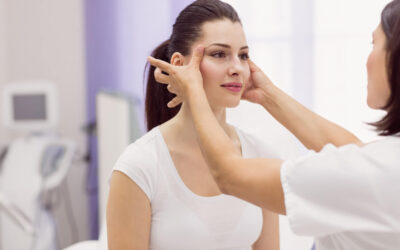In the world of cosmetic enhancements, Botox and dermal fillers are two of the most popular non-surgical treatments for facial rejuvenation. Both promise smoother, younger-looking skin, but they work in very different ways. If you’re considering one (or both) of these treatments, it’s essential to understand their differences, benefits, and ideal uses.
This comprehensive guide will break down everything you need to know about Botox vs. dermal fillers, helping you decide which option—or combination—is best for your aesthetic goals.
Understanding Botox and Dermal Fillers
What Is Botox?
Botox (Botulinum Toxin Type A) is a neurotoxin that temporarily paralyzes muscles responsible for dynamic wrinkles—those caused by repetitive facial expressions (like frown lines, crow’s feet, and forehead wrinkles).
How Botox Works:
-
Injects a purified protein into targeted muscles.
-
Blocks nerve signals, preventing muscle contractions.
-
Softens wrinkles within 3–7 days, with full results in about two weeks.
-
Lasts 3–6 months before gradually wearing off.
Best for:
-
Forehead lines
-
Frown lines (glabellar lines)
-
Crow’s feet
-
Bunny lines (nose wrinkles)
-
Jaw slimming (masseter Botox)
-
Excessive sweating (hyperhidrosis)
What Are Dermal Fillers?
Dermal fillers are gel-like substances (usually hyaluronic acid, calcium hydroxylapatite, or poly-L-lactic acid) injected beneath the skin to restore lost volume, smooth wrinkles, and enhance facial contours.
How Dermal Fillers Work:
-
Add volume to hollow or sagging areas.
-
Stimulate collagen production (long-term benefits).
-
Immediate results, with some fillers lasting 6–24 months.
Best for:
-
Nasolabial folds (smile lines)
-
Marionette lines (mouth corners)
-
Cheek augmentation
-
Lip enhancement
-
Under-eye hollows
-
Jawline contouring
Key Differences Between Botox and Fillers
| Feature | Botox | Dermal Fillers |
|---|---|---|
| Primary Use | Relaxes muscles to reduce wrinkles | Adds volume to smooth wrinkles & enhance shape |
| Best For | Dynamic wrinkles (expression lines) | Static wrinkles (volume loss) |
| Results Time | 3–14 days | Immediate |
| Longevity | 3–6 months | 6–24 months (varies by type) |
| Common Areas | Forehead, eyes, frown lines | Cheeks, lips, jawline, under-eyes |
| Pain Level | Mild (tiny needle) | Mild to moderate (numbing cream helps) |
| Cost (Avg.) | $10–$20 per unit | $600–$1,200 per syringe |
Which One Should You Choose?
Choose Botox If You Want To:
✔ Reduce forehead wrinkles, crow’s feet, or frown lines.
✔ Prevent deeper wrinkles from forming (preventative Botox in late 20s/30s).
✔ Address excessive sweating (hyperhidrosis) or jaw clenching (Botox for TMJ).
Choose Dermal Fillers If You Want To:
✔ Restore lost volume in cheeks or under-eyes.
✔ Plump thin lips or define the jawline.
✔ Smooth deep nasolabial folds or marionette lines.
Combination Approach (Botox + Fillers)
Many patients opt for both treatments for a complete facial rejuvenation:
-
Botox relaxes expression lines.
-
Fillers restore volume and contour.
Potential Side Effects & Safety
Botox Risks:
-
Temporary bruising/swelling.
-
Mild headache or drooping (rare, if injected improperly).
-
Results fade naturally over time.
Filler Risks:
-
Swelling, redness, or bruising.
-
Lumps (if not massaged properly).
-
Vascular occlusion (very rare with experienced injectors).
Always choose a board-certified dermatologist or plastic surgeon for injections.
Cost Comparison: Botox vs. Fillers
-
Botox: $10–$20 per unit (average treatment: 20–60 units).
-
Fillers: $600–$1,200 per syringe (most need 1–3 syringes).
Factors Affecting Cost:
-
Provider’s expertise.
-
Geographic location.
-
Type of filler (e.g., Juvederm vs. Sculptra).
Final Verdict: Which Is Right for You?
| You Might Prefer Botox If… | You Might Prefer Fillers If… |
|---|---|
| You have dynamic wrinkles (forehead, crow’s feet). | You have volume loss (cheeks, lips). |
| You want preventative anti-aging. | You want immediate plumping. |
| You prefer shorter-term results. | You want longer-lasting effects. |
Best Option? Consult a Specialist!
A skilled injector can assess your facial structure and recommend the best treatment—or combination—for natural-looking results.
Conclusion
Both Botox and dermal fillers offer incredible anti-aging benefits, but they serve different purposes. Botox is ideal for smoothing expression lines, while fillers excel at restoring volume and enhancing facial contours.
For the most comprehensive rejuvenation, many patients choose a combination of both. The key is selecting an experienced injector who can tailor treatments to your unique facial anatomy.
Ready to take the next step? Book a consultation with a board-certified specialist to explore your options!




